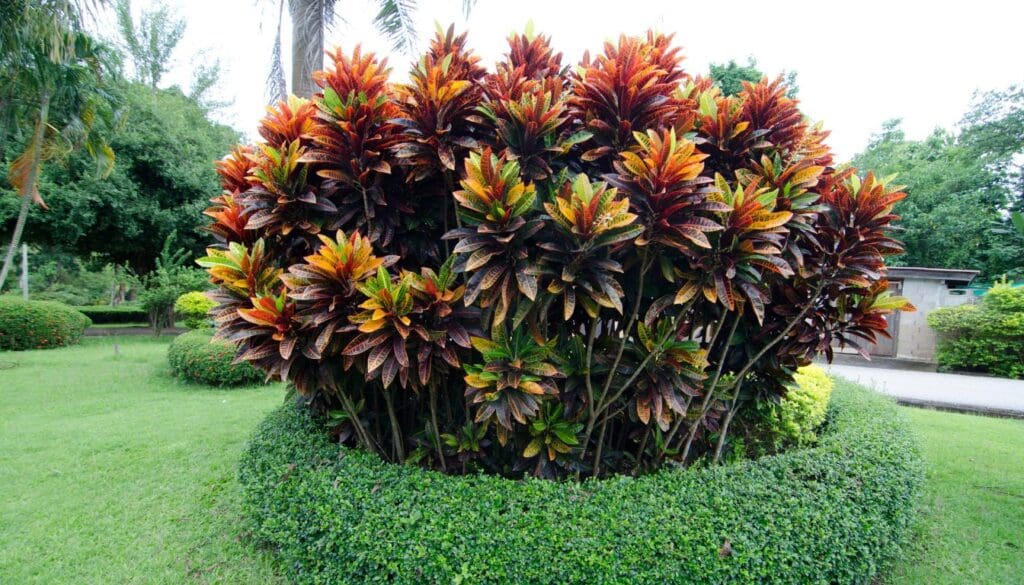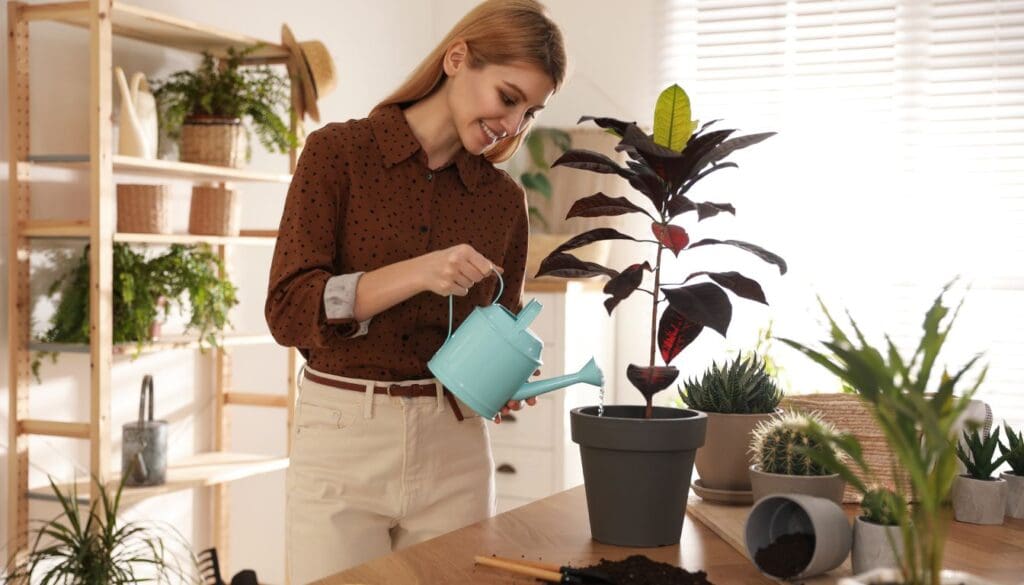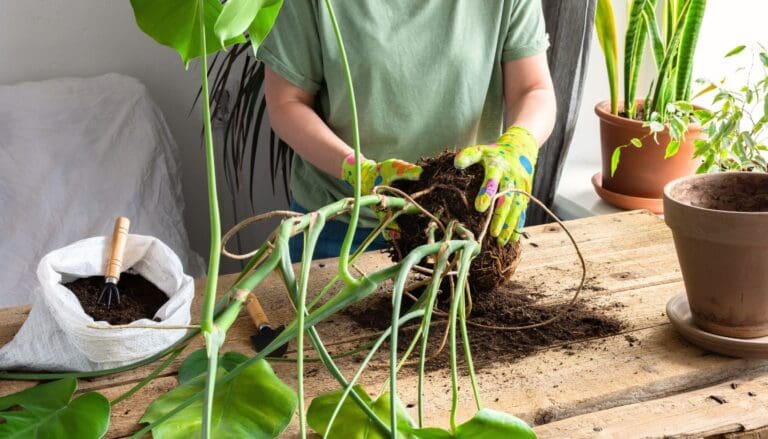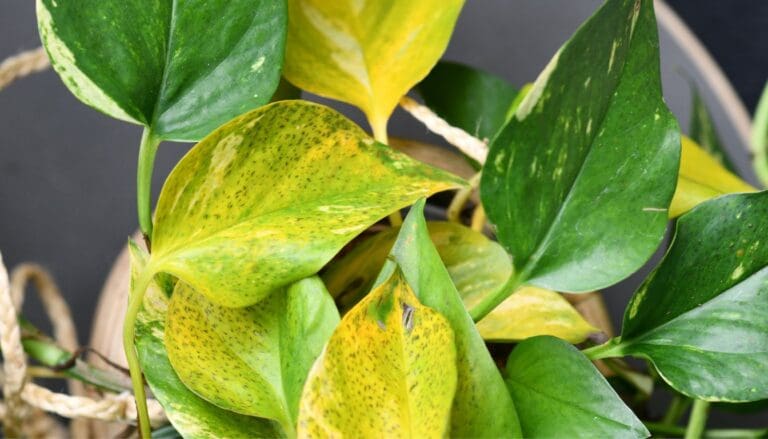Can Croton Grow Outside? (Requirements & Care Difference)
Crotons are tropical perennials originating from Malaysia, India, and other regions of Asia. They have gained popularity as houseplants because of their stunning foliage.
But some people imagine keeping them in their patio and backyard as well. But can crotons grow outside? Let’s find out.
As a general rule, Crotons can be grown outdoors in the USDA zones 9-11, where temperatures remain above 60°F. They prefer a warm and humid environment to thrive, so if you live in an area prone to cold winter and snow, you should consider growing them indoors.
In this article, I will take you through all the factors you need to consider before growing crotons outside.

Please note: Simplify Plants is reader-supported. Some links in the post are affiliate links and I get a commission from purchases made through links in the post.
Does croton do well outside?
Plants initially grew outdoors in the wild before being brought into the houses and grown as houseplants.
But, for a plant to do well outside, it will require conditions similar to its natural habitat.
If you want to grow your croton outside, you must first understand the basic requirements of the plant and match it with the external conditions.
If your area has suitable light, temperature, and humidity levels for the croton, you can take it or plant it outside, and it will do well.
But if the external conditions are not suitable for the croton, avoid growing it outside and keep it indoors.
Factors that affect the growth of croton outside
Before you take your croton outside, consider these factors and ensure that they align with the plant’s requirements.
The factors we are talking about are:
- Light
- Temperature
- Humidity
- Wind
- Watering
- Placement
Let’s dive into the details of each factor.
Light requirement of croton

Crotons do well in full sun and bright indirect light.
If you are growing the croton outside, find a spot that gets direct sunlight or indirect bright light throughout the day.
However, crotons will need to be protected from the intense afternoon heat and sunlight.
If you keep your potted croton outside, you can bring it to a shadier spot when the sun becomes too intense.
On the other hand, if you plant the proton in your garden, you can plant it under a big tree to protect it from the intense afternoon sun.
Can croton be in direct sunlight?
Unlike many houseplants, crotons can thrive under direct sunlight.
However, that depends on the species of your croton.
For example, Yellow Iceton Croton and Superstar Croton can tolerate direct sunlight, but species like Victoria Gold Bell Croton and Sunny Star Croton will do well in indirect sunlight.
Whichever croton species you are growing, avoid exposing it to the intense afternoon sun.
Also read: What Kind Of Light Does A Croton Need? (Croton Light Requirements )
Temperature requirement of croton

Croton is a tropical plant, so it prefers warm conditions.
The ideal temperatures for croton will remain between 65-80°F.
Although crotons can tolerate lower and higher temperatures than the ideal range, you should keep them in the ideal ones.
The temperature requirement is the same for both indoor and outdoor crotons.
What temperature can croton tolerate?
Crotons can tolerate low temperatures of 40°F and high temperatures of 100°F, but these are not ideal for the plant.
The croton will get stressed if the temperatures go higher or lower than the plant’s preference.
So, avoid growing the croton in a spot with too high or low temperatures.
Also read: What Temperature Can Croton Tolerate? (+Ideal Temperature Range)
Humidity requirement of croton

Croton comes from tropical regions where the humidity levels remain high, so this plant prefers high humidity.
The humidity levels usually remain higher inside the house than outside.
You should ensure that the humidity levels don’t go below 40% outside.
One great way to maintain a humid atmosphere around the plant is by grouping crotons in the garden.
Growing a lot of crotons together makes your garden look good and makes the environment humid by the transpiration of the plants.
Or, you can shower the plant to increase the humidity for it.
Ensure that the plant has good airflow and gets proper sunlight to dry out that water.
Also read: Do Crotons Need Misting? (+Maintaining Ideal Humidity)
Can croton survive winter outside?
Winters are harsh when the temperatures go low, and the air becomes dry.
If the croton is exposed to such conditions when growing outside, it will get damaged and might die if you don’t do anything about it.
But, you can save your croton and help it survive if you prepare for the winter.
If the temperatures go below 45-50°F, you must cover your crotons beforehand to protect them from harsh conditions.
You can use a blanket or thick plastic to cover the crotons.
You can also mulch the soil around the crotons to help them survive winter.
However, if you have potted crotons, you can just bring them inside the house.
Also read: Can Crotons Survive Winter? (Common Problems+Care Guide)
Wind
Crotons don’t like low temperatures, frost, or too much wind.
So, if you live in a windy zone, it would be better to keep the croton inside.
However, if the wind is mild or occurs in only a few days, you can cover the plants to prevent any damage.
Watering the croton growing outside

Crotons prefer moist soil and therefore require water whenever the top layers of the soil get dry.
However, the water requirement of croton growing outside will be higher than croton growing indoors.
It happens because the sunlight exposure is more outside, which increases the rate of evaporation, due to which the plant gets thirsty faster.
The wind also plays a role here and helps the soil dry faster.
Therefore, you must water the croton more frequently when growing outside.
However, always check the soil moisture to avoid overwatering and use a moisture meter if you don’t know how to determine the moisture.
Also read: How Often To Water Croton Plant? (Watering Schedule+Watering Problems)
Placement of croton outside
If you want to plant your croton outside, you can plant it around fountains.
You can also plant it close to your house.
If you are planting croton in the garden, try to plant it in a raised garden bed and at the same depth as crotons growing in containers.
If you want to plant many croton plants together, keep at least 3 feet distance between them to allow proper airflow around the plants.
If you have potted crotons, you can place them and relocate them as and when required.
You must use an appropriate soil mix for growing croton in the garden or the pot.
The soil should hold enough water to keep it moist but dry fast so that excess water doesn’t make the soil soggy and affect the roots.
Before planting the crotons in your garden, check the roots and ensure they are not crowded.
You can loosen them up with your hand before planting if they are.
How to care for outdoor croton?

When you are growing croton outside, it will require a little different care from the inside.
Go through these tips that will help you take care of your outdoor croton:
- Water your crotons well before the arrival of winter. This will insulate the roots of the crotons. After this, cover them with a blanket to protect them from cold.
- You can bring potted crotons indoors during harsh winters if you have potted crotons.
- Grow the crotons away from the direct intense sunlight, predominantly afternoons.
- When preparing the soil bed for your croton, use well-drained soil that will not allow waterlogging.
- Avoid planting the crotons too deep as that will stress out the plants.
- After planting the crotons in your garden, water them thoroughly to let the roots adjust to the new environment.
- When the temperatures increase during the summer months, water them thoroughly to provide moisture and humidity.
- Crotons can grow tall and bushy, so prune them whenever required, as they can become leggy and uneven without pruning.
- Mulch the ground around the crotons with organic matter to protect the roots from the cold and provide nutrients.
- Avoid transplanting the croton too frequently as crotons get stressed and don’t prefer it. It would be best to transplant them only when required, once 3-5 years.
- Don’t plant your crotons at a spot where they will be exposed to cold northern winds.
- Keep the leaves of your Croton clean, as the leaves tend to accumulate more dust when growing outside. You can use a wet cloth to clean the leaves or shower the plant and wipe the leaves with a napkin.
- Watch out for pests as the possibilities of pest infestations are more outside. Spray a neem oil solution on your Croton to keep the pests away.
Final words

Crotons are grown outside in tropical climates, but they will require extra care and attention to survive outside in other climate zones. If you live in the cold region, I recommend growing crotons indoors.
But, if you live in the USDA zones 9-11, you can grow crotons outside. However, be prepared to protect them when the conditions become too harsh during the winters.
If you want to avoid all these troubles and still want to have crotons outside, grow them in pots and place them outside the house. You can bring the pots inside the house whenever the conditions become unsuitable for the plants.
Reference: Sciencedirect, Wikipedia, Wikipedia, Britannica, CABI, Academia, University of South Florida, The University of Georgia.
Recommended Garden Supplies
| Product Image | Our Recommended Gardening Supplies | Check Offers! |
|---|---|---|
Top Top
Top
Top
Top
Top
Top
Top
Top | rePotme Houseplant and Tropical Classic Potting Soil Mix | Check Offer On Amazon |
 Top
Top
Top
Top
Top
Top
Top
Top | Espoma Organic Indoor Plant Food | Check Offer On Amazon |
 Top
Top
Top
Top
Top
Top
Top
Top | GooingTop LED Grow Light 6000K Full Spectrum Clip Plant Growing Lamp | Check Offer On Amazon |
 Top
Top
Top
Top
Top
Top
Top
Top | Soil Moisture Meter | Check Offer On Amazon |
 Top
Top
Top
Top
Top
Top
Top
Top | Govee Hygrometer Thermometer, Bluetooth Enabled! | Check Offer On Amazon |
 Top
Top | LEVOIT Humidifiers for Large Room(Best For Plants) | Check Offer On Amazon |
 Top
Top
Top
Top
Top
Top
Top
Top | Upgraded DIY Automatic Drip Irrigation Kit, 15 Potted Houseplants Support | Check Offer On Amazon |
 Top
Top
Top
Top
Top
Top
Top
Top | Stainless Steel Heavy Duty Gardening Tool Set | Check Offer On Amazon |
 Top
Top
Top
Top
Top
Top
Top
Top | Bonide Insecticidal Soap | Check Offer On Amazon |
 Top
Top
Top
Top
Top
Top
Top
Top | Bonide 32 oz Spray Neem Oil for Organic Gardening | Check Offer On Amazon |
 Top
Top
Top
Top
Top
Top
Top
Top | Garden Safe Fungicide | Check Offer On Amazon |






